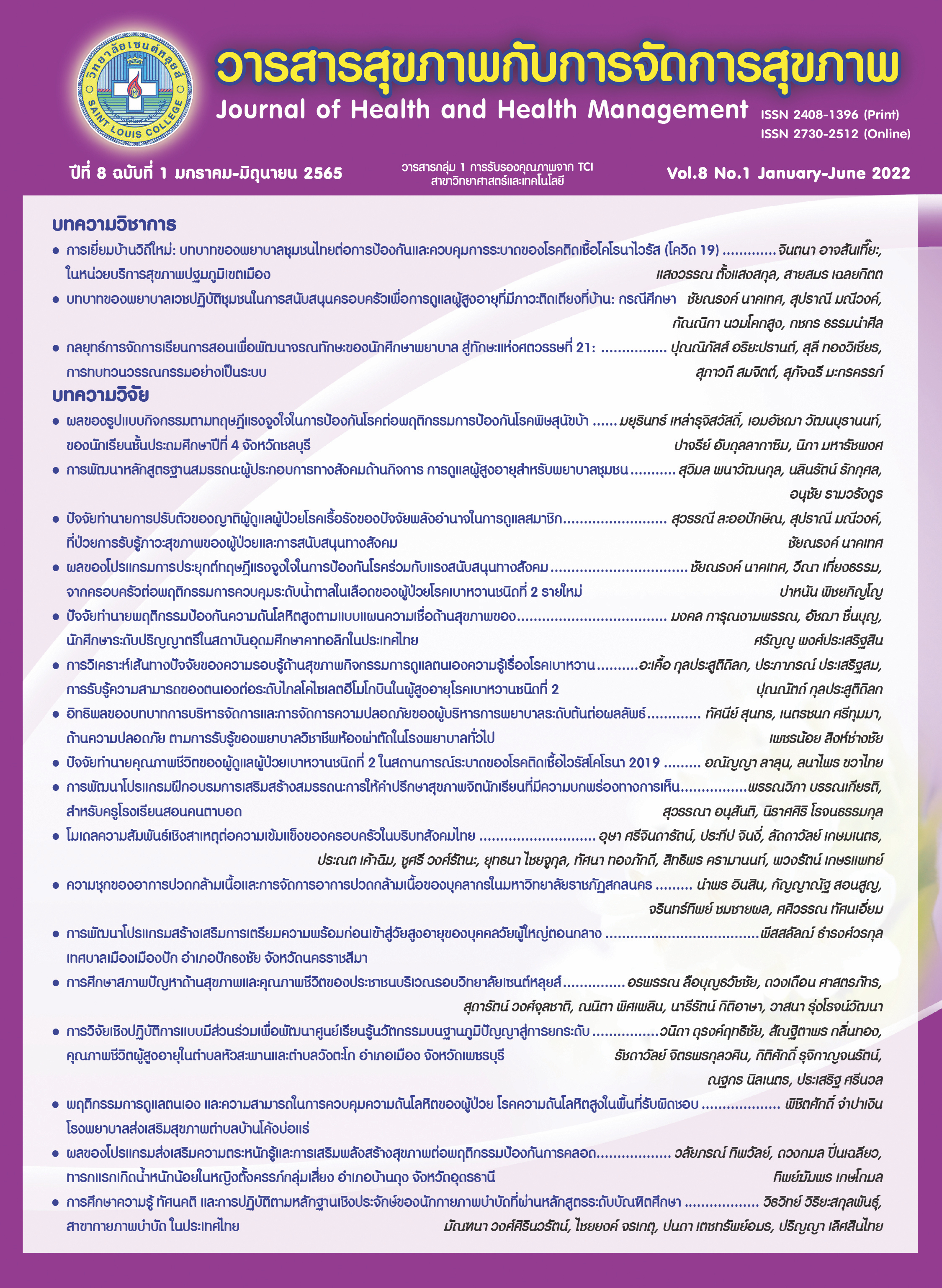Teaching Strategies Enhancing Develop Soft Skills of Nursing Students Towards The 21st Century Skills: A systematic literature review
Keywords:
Teaching strategies, Soft Skills, Nursing Students, The 21st Century SkillsAbstract
This paper reviewed the existing researches on teaching strategies enhancing to develop soft skills of nursing students towards the 21st century skills. Following preferred reporting items for systematic reviews and meta-analyses (PRISMA), PubMed, Science Direct, Sage Publication, ProQuest, CINAHL, EBSCOhost, Google Scholar, and ThaiJO were included in electronic databases. Researches on teaching and learning strategies for developing the skills of nursing students published between 2017 and 2021 were included in the review, 6 papers were synthesized. Findings show that there are 4 types of teaching and learning management models for developing the skills of nursing students towards 21st century skills, as follows: 1) collaborative mentoring model 2) service learning model 3) Web-based or Game-based learning and 4) role playing. This review has pointed out that learning management strategies are varied based on the course context which placed the important on student-centered. Developing nursing students to have skills for the 21st century is imperative. This will lead to quality service to patients that conveyed from student’s capacity to communicate, think analytically, and effectively resolve immediate situations
References
จินดารัตน์ โพธิ์. (2559). จรณทักษะ. สำนักงานราชบัณฑิตยสภา.สืบค้นจาก: http://legacy.orst.go.th/
ชัชวาล วงค์สารี สุระพรรณ พนมฤทธิ์ สายสมรเฉลยกิตติ วลัยนารี พรมลา ธนันต์นิภา ภัคศุขนิธิวัฒน์และสุทธิชารัตน์ เจริญพงศ์. (2564). การสังเคราะห์งานวิจัยเชิงทดลองและกึ่งทดลองสำหรับการส่งเสริมสุขภาพผู้สูงอายุไทยในปัจจุบัน. วารสารสุขภาพกับการจัดการสุขภาพ, 7(2), 16-29.
ดนุลดา จามจุรี. (2563). การออกแบบการเรียนรู้สำหรับผู้เรียน Gen Z. กรุงเทพฯ: บัณฑิตวิทยาลัยมหาวิทยาลัยศรีนครินทรวิโรฒ.
ทัศนีย์ เกริกกุลธร, ประกริต รัชวัตร์, และ วิภาศิริ นราพงษ์.(2013). การใช้หลักฐานเชิงประจักษ์กับการเรียนรู้สู่อัตลักษณ์บัณฑิต วิทยาลัยพยาบาลบรมราชชนนีสระบุรี. EAU Heritage Journal, 7(2), 108-119.
ปกรณ์ โปรยรุ่งโรจน์ และณกมล จันทร์สม. (2564).ปัจจัยด้านจรณทักษะ (Soft Skill) ที่ส่งผลต่อประสิทธิภาพการปฏิบัติงานของพนักงานกลุ่มเจเนอเรชั่นวายในกรุงเทพมหานคร. วารสารรัชต์ภาคย์, 15(42), 117-128.
ไพรวัลย์ โคตรตะ สุวิมล โพธิ์กลิ่น และอภิชัย กรมเมือง. (2560). อนาคตภาพของการจัดการศึกษาหลักสูตรพยาบาลศาสตรบัณฑิตในบริบทประชาคมอาเซียน.JOURNAL OF HEALTH SCIENCE RESEARCH.11(2), 18-27.
มารุต พัฒผล. (2562).รูปแบบการพัฒนาหลักสูตรร่วมสมัย. กรุงเทพมหานคร: ศูนย์ผู้นำนวัตกรรมหลักสูตรและการเรียนรู้.
มาลี คำคงยุวนิดา อารมรมย์ และสุระพร ปุ้ยเจริญ. (2563).ทักษะที่ไม่ใช่ทางเทคนิค: การจัดการเรียนรู้ ภาคปฏิบัติทางการพยาบาล. วารสารเครือข่ายวิทยาลัยพยาบาลและการสาธารณสุขภาคใต้, 7(6), 312-323.
ละเอียด แจ่มจันทร์, สุภัจฉรี มะกรครรภ์, และ สมฤดี กีรตวนิชเสถียร. (2562). การพัฒนาซอล์ฟสกิลของนักศึกษาพยาบาลการเรียนรู้จากเครือข่ายความร่วมมือประกันคุณภาพการศึกษา. วารสารพยาบาลสาธารณสุข, 33(2), 130-140.
วิจารณ์ พานิช. (2556). วิถีสร้างการเรียนรู้เพื่อศิษย์ (พิมพ์ครั้งที่ 3). กรุงเทพมหานคร: ฝ่ายโรงพิมพ์ บริษัท ตถาตา พับลิเคชั่น.
วิริยา โพธิ์ขวาง ชนก จามพัฒน์ เบญจวรรณ งามวงศ์วิวัฒน์ นงนุช วงศ์สว่าง และสุภาเพ็ญ ปาณะวัฒนพิสุทธิ์.(2562). การเตรียมรายงานวิจัยต้นฉบับและการประเมินคุณภาพงานวิจัยทางการพยาบาลและสาธารณสุข. The Journal of Baromarajonani College of Nusing, Nakhonratchasima,25(2), 194-212.
สภาการพยาบาล. (2561). สมรรถนะหลักของผู้สำเร็จการศึกษาระดับปริญญาตรี ปริญญาโท ปริญญาเอก สาขาพยาบาลศาสตร์หลักสูตรฝึกอบรมการพยาบาลขั้นสูงระดับวุฒิบัตรและได้รับวุฒิบัตร/หนังสืออนุมัติแสดงความรู้ความชำนาญ ทางการพยาบาลและการผดุงครรภ์และการพยาบาลเฉพาะสาขาทางสาขาพยาบาลศาสตร์. สืบค้นจาก: https://www.tnmc.or.th/news/124
สุเมธ แย้มนุ่น. (2559). เอกสารนำเสนอเรื่อง การวางแผนเพื่อการเปลี่ยนแปลงของระบบอุดมศึกษาในระยะ 15 ปี (ประธานคณะอนุกรรมการกรอบแผนอุดมศึกษาระยะยาว 15 ปี ฉบับที่ 3 (พ.ศ.2560-2574) และแผนพัฒนาการศึกษาระดับอุดมศึกษา ฉบับที่ 12 (พ.ศ. 2560-2564).สืบค้นจาก: https://www.stou.ac.th/offices/opr/planning/pl_main_v2.1/roadmap20/Document/07.pdf
สำนักงานเลขาธิการสภาการศึกษา. (2560). แผนการศึกษาแห่งชาติ พ.ศ. 2560-2574. กรุงเทพฯ : พริกหวานกราฟฟิค จำกัด. สืบค้นจาก : http://www.lampang.go.th/public60/EducationPlan2.pdf
สำนักงานเลขาธิการสภาการศึกษา. (2563). “ทักษะเด็ด2020” : วัคซีนทักษะ ปะทะ DIGITAL DISRUPTION. สืบค้นจาก: http://www.onec.go.th/index.php/page/view/Outstand/4036
สำนักส่งเสริมและพัฒนาศักยภาพนักศึกษา สำนักงานปลัดกระทรวงการอุดมศึกษา วิทยาศาสตร์ วิจัยและนวัตกรรม. (2562). ยุทธศาสตร์การพัฒนานิสิต นักศึกษาในสถาบันอุดมศึกษา (พ.ศ. 2560 - 2564). (พิมพ์ครั้งที่ 2). สืบค้นจาก: https://sdd.snru.ac.th/wp-content/uploads/2020
อัจฉรา คำมะทิตย์. (2564). หลักฐานเชิงประจักษ์ทางการพยาบาล: ค้นหา วิเคราะห์ และนำไปใช้อย่างไร. The Southern College Network Journal of Nursing and Public Health, 8(2), 315-328.
อัจฉรา คำมะทิตย์ และมัลลิกา มากรัตน์. (2559). การทบทวนวรรณกรรมอย่างเป็นระบบ: วิธีการปฏิบัติทีละขั้นตอน.วารสารเครือข่ายวิทยาลัยพยาบาลและการสาธารณสุขภาคใต้, 3(3), 246-259.
Liberati, A., Altman, D. G., Tetzlaff, J., Mulrow, C., Gøtzsche, P. C., Ioannidis, J. P., ... & Moher, D. (2009). The PRISMA statement for reporting systematic reviews and meta-analyses of studies that evaluate health care interventions: explanation and elaboration. Journal of clinical epidemiology, 62(10), 1-34.
Ebrahim Aliafsari Mamaghani, sharareh ahmadzadeh. (2021). Role Playing Is a Useful Method for Teaching Physical Examinations, doi: https://doi.org/10.21203/rs.3.rs-582816/v1
Felder, R. M., & Brent, R. (1996). Navigating the bumpy road to student-centered instruction. College teaching, 44(2), 43-47.
Hardie P, Darley A, Catherine Redmond C, Lafferty A, Jarvis S. (2021). Interpersonal and communication skills development in nursing preceptorship education and training programmes: a scoping review protocol. HRB Open Research 2021, 4(9), https://doi.org/10.12688/hrbopenres.13201.2
Hariti, T., & Rejeki, S. (2020). Strengthening soft skills as the character of student nurses through the preceptorship management model. Enfermeria Clinica, 30(6), 64-68.
Holly C, Salmond S, Saimbert M. Comprehensive systematic review for advanced.practice nursing (2nded). New York: Springer Publishing Company; 2017.
Luke Laari, Barbara M. Dube. (2017). Nursing students’ perceptions of soft skills training in Ghana. Curationis. 3(1), 54-61.
Luke Laari, Oboshie Anim-Boamah, Christian Makafui Boso. (2021). Integrative review of soft skills the desirable traits and skills in nursing practise, doi: https://doi.org/10.21203/rs.3.rs-605637/v1
Martina, S. E., Purba, I. E., Sinaga, J., & Simanjuntak, E. H. (2022). Self-efficacy impact of the Mini-CEX among nursing students in North Sumatera, Indonesia. Journal of Public Health Research, 11(2).
Downloads
Published
How to Cite
Issue
Section
License
Copyright (c) 2022 Journal of health and health management

This work is licensed under a Creative Commons Attribution-NonCommercial-NoDerivatives 4.0 International License.




